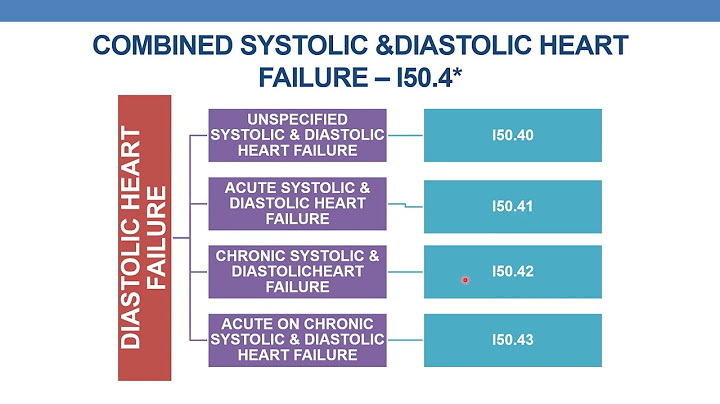Last reviewed: 10 Sep 2022 Show
Last updated: 27 Mar 2019 SummaryHeart failure is a complex clinical syndrome resulting from the impaired ability of the heart to cope with the metabolic needs of the body, resulting in breathlessness, fatigue, and fluid retention. Approximately half of patients with heart failure have normal, or near-normal, left ventricular ejection fraction and are classified as having heart failure with preserved ejection fraction. The most common risk factors are advanced age, female sex, hypertension, obesity, chronic kidney disease, diabetes mellitus, and coronary artery disease. Patients may present with acute decompensated heart failure and are generally managed with diuresis, blood pressure control, and treatment of ischemia and tachyarrhythmia, when present. No therapy has been shown to improve survival in randomized control trials. Risk factor modification and diuretics where there is evidence of fluid overload are the cornerstones of long-term management. DefinitionHeart failure (HF) is a complex clinical syndrome resulting from the impaired ability of the heart to cope with the metabolic needs of the body, resulting in breathlessness, fatigue, and fluid retention. HFpEF was previously referred to as "diastolic" HF. This was in comparison to "systolic" HF, which corresponded with heart failure with reduced ejection fraction (HFrEF). However, diastolic dysfunction has been shown not to be unique to HFpEF, as evidence of diastolic dysfunction may also be found in systolic heart failure. The term "heart failure with normal ejection fraction" (HFnEF) was used briefly, although newer imaging techniques have confirmed that systolic function in HFpEF patients is not completely normal, with reduced long axis function and extensive but subtle changes on exercise.[1] As the exact range of normal function is difficult to define and the left ventricular function is not thought to be entirely normal in these patients, the term "HFpEF" has now been adopted. Patients with HFpEF have the clinical signs of heart failure with normal or near-normal left ventricular function and no significant valvular abnormalities (i.e., no significant aortic stenosis or mitral regurgitation).[2] The exact pathophysiology of HFpEF remains uncertain, although impaired isovolumetric ventricular relaxation, decreased left ventricular compliance, and increased left ventricle passive stiffness are consistently reported among all patients.[3][4] Patients often have overlapping comorbidities, and it has only recently been convincingly demonstrated that HFpEF represents more than a sum of all its comorbidities and is a condition in its own right.[5] HFpEF is likely to be due to diastolic dysfunction, impaired systolic function on exercise, abnormal ventricular-arterial coupling, inflammation and endothelial dysfunction, chronotropic incompetence, altered myocardial energetics and peripheral skeletal muscle metabolism and perfusion, pulmonary hypertension, and renal insufficiency.[4] In 2016, the European Society of Cardiology updated their diagnostic guidelines, introducing a third category, heart failure with mid-range ejection fraction (HFmrEF). This resulted in defining HFpEF as patients with symptoms and signs of heart failure, raised natriuretic peptides, left ventricular ejection fraction (LVEF) >50%, and structural heart disease and/or diastolic dysfunction. HFrEF is defined as LVEF <40%, with HFmrEF as LVEF 41% to 49% with structural heart disease and/or diastolic dysfunction.[6] History and examKey diagnostic factors
More key diagnostic factors Other diagnostic factors
Other diagnostic factors Risk factors
More risk factors Diagnostic investigations1st investigations to order
More 1st investigations to order
Investigations to consider
More investigations to consider Treatment algorithmacute decompensated HFpEFchronic HFpEFContributorsAuthorsGerald Carr-White, PhD, FRCPConsultant Cardiologist Guys and St Thomas’ NHS Foundation Trust London UK DisclosuresGCW has been reimbursed by Pfizer, Astra Zenica, Bayer, Medtronic, St Jude, and Sanofi for attending conferences. He has attended Advisory Boards for Medtronic, St Jude, Novartis, Shire, Sanofi and Servier, and has a joint working venture with Novartis for a community pharmacist post. Jessica Webb, BM, BCh, MA, MRCP, FHEACardiology Specialist Registrar Guys and St Thomas’ NHS Foundation Trust London UK DisclosuresJW declares that she has no competing interests. AcknowledgementsDr Gerald Carr-White and Dr Jessica Webb would like to gratefully acknowledge Dr Gerard Aurigemma, Dr Lokesh Tejwani, Dr Marc E. Del Rosario, and Dr Kul Aggarwal, previous contributors to this topic. GA, LT, MEDR, and KA declare that they have no competing interests. Peer reviewersEdward Geltman, MDProfessor of Medicine Cardiovascular Division Washington University School of Medicine St. Louis MO DisclosuresEG has lectured for Novartis, Forest, Merck, and Pfizer. Jerry Murphy, MB, BS, DM, FRCPConsultant Cardiologist Darlington Memorial Hospital Darlington UK DisclosuresNot disclosed. What is the most common cause of heart failure with a preserved ejection fraction?The high prevalence of comorbid cardiovascular disease and cardiovascular risk factors in HFpEF is well recognized (Figure 2). The most prevalent cardiovascular disease in HFpEF is hypertension, which is present in the large majority of HFpEF cases across epidemiological and registry studies.
How long can you live with heart failure with preserved ejection fraction?A 2017 study found that all people hospitalized with heart failure survived for a median of 2.1 years. Roughly 75 percent of people hospitalized with HFpEF in this study passed away within five years. Cardiovascular and HF readmission rates were higher in those with HFrEF than those with HFpEF.
What stage of heart failure is HFpEF?Heart failure with preserved ejection fraction (HFpEF) occurs when the lower left chamber (left ventricle) is not able to fill properly with blood during the diastolic (filling) phase. The amount of blood pumped out to the body is less than normal. It is also called diastolic heart failure.
Is preserved ejection fraction serious?Conclusions: Heart failure with preserved ejection fraction has a poor prognosis, comparable with that of HF with reduced EF, with a 5 year survival rate after a first episode of 43% and a high excess mortality compared with the general population.
|

Related Posts
Advertising
LATEST NEWS
Advertising
Populer
Advertising
About

Copyright © 2024 en.apacode Inc.


















